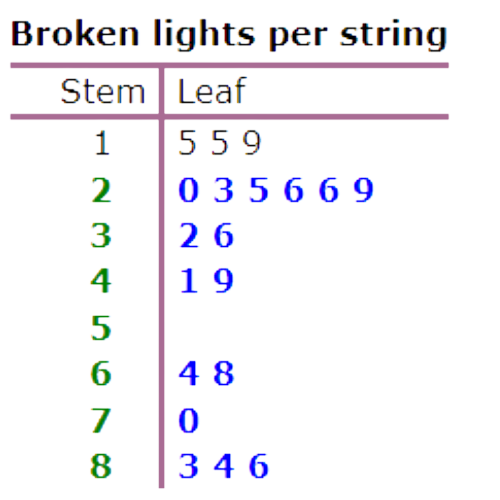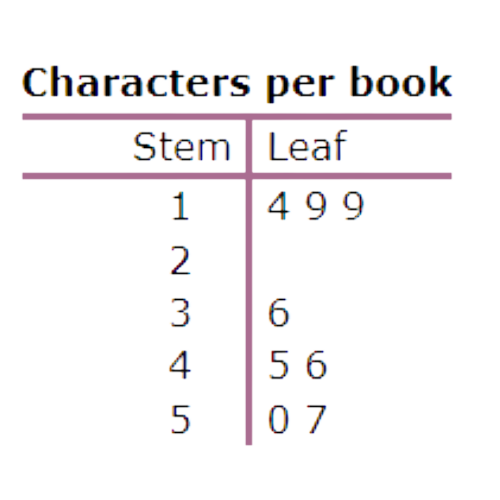Interpret stem-and-leaf plots
Key Notes:
1. Understanding a Stem-and-Leaf Plot
- Stem-and-Leaf Plot: A way to organize and display numerical data where each number is split into a “stem” (the leading digit(s)) and a “leaf” (the last digit).
- Purpose: To quickly show the distribution of data and identify patterns like the median, mode, range, and outliers.

2. Components of a Stem-and-Leaf Plot
- Stem: Represents the leading digit(s) of each number. For example, in the number 47, the stem would be 4.
- Leaf: Represents the last digit of each number. In the number 47, the leaf would be 7.
- Key: A key is usually provided to explain how to read the plot. For example, “4 | 7 means 47.”
3. Steps to Interpret a Stem-and-Leaf Plot
- Step 1: Read the Key
- Start by understanding the key to know how to read the stems and leaves.
- Step 2: Identify the Data Points
- Combine the stem and leaf to form the original numbers. For example, if the stem is 5 and the leaf is 3, the number is 53.
- Step 3: Analyze the Distribution
- Range: Find the difference between the highest and lowest values by looking at the first and last numbers.
- Median: Locate the middle value by counting from both ends of the list.
- Mode: Identify the most frequent data point by observing which leaf appears most often.
- Clusters and Gaps: Notice any clusters of data (where many numbers are close together) and gaps (where few or no numbers appear).
4. Example of a Stem-and-Leaf Plot
- Data Set: 32, 34, 36, 41, 42, 43, 45, 47, 52, 53, 53, 54, 61.
- Stem-and-Leaf Plot

- Key: 3 | 2 means 32.
5. Analyzing the Example Plot
- Range: The range is 61 – 32 = 29.
- Median: The middle value is the 7th number (45).
- Mode: The number 53 appears most often.
- Clusters: There’s a cluster around 40-50.
- Gaps: There is a gap between the leaf values from 6 to 1 in the stems 3 and 4.
6. Benefits of Stem-and-Leaf Plots
- Detailed View: Shows individual data points while also providing a visual distribution.
- Quick Analysis: Allows for rapid identification of key statistical concepts like median and mode.
- Comparison: Makes it easier to compare different sets of data, especially in finding where data clusters.
7. Common Mistakes to Avoid
- Misinterpreting the Key: Always read the key correctly to avoid confusion between stems and leaves.
- Forgetting to Order the Leaves: Leaves should be listed in ascending order for clarity.
- Overlooking the Range and Gaps: Always check the full spread of data and note any significant gaps.
8. Practical Tips
- Practice reading different stem-and-leaf plots to get comfortable with the format.
- Pay attention to the shape of the distribution, as it can indicate the nature of the data set.
- Use stem-and-leaf plots to double-check calculations like median or mode.
Learn with an example
🔭 While hanging Christmas lights for neighbours, Hansen counted the number of broken lights on each string.

🔭 How many strings had at least 20 broken lights but less than 90 broken lights?
—–strings.
Count all the leaves in the rows with stems 2, 3, 4, 5, 6, 7, and 8.

You counted 16 leaves, which are blue in the stem-and-leaf plot above. 16 strings had at least 20 broken lights but less than 90 broken lights.
🔭 During Fitness Day at school, Martin and his classmates took part in a pull-up competition, keeping track of the results.

🔭 How many people did exactly 54 pull-ups?—– people
For the number 54, the stem is 5, and the leaf is 4. Find the row where the stem is 5. In that row, count all the leaves equal to 4.

You counted 2 leaves, which are blue in the stem-and-leaf plot above. 2 people did exactly 54 pull-ups.
🔭 Sean kept track of the number of characters in each book he read.

🔭 What is the largest number of characters?——characters.

Look at the last row of the stem-and-leaf plot. The last row has the highest stem. The stem for the last row is 5.
Now find the highest leaf in the last row. The highest leaf is 7.
The largest number of characters has a stem of 5 and a leaf of 7. Write the stem first, then the leaf: 57.
The largest number of characters is 57 characters.
let’s practice!

